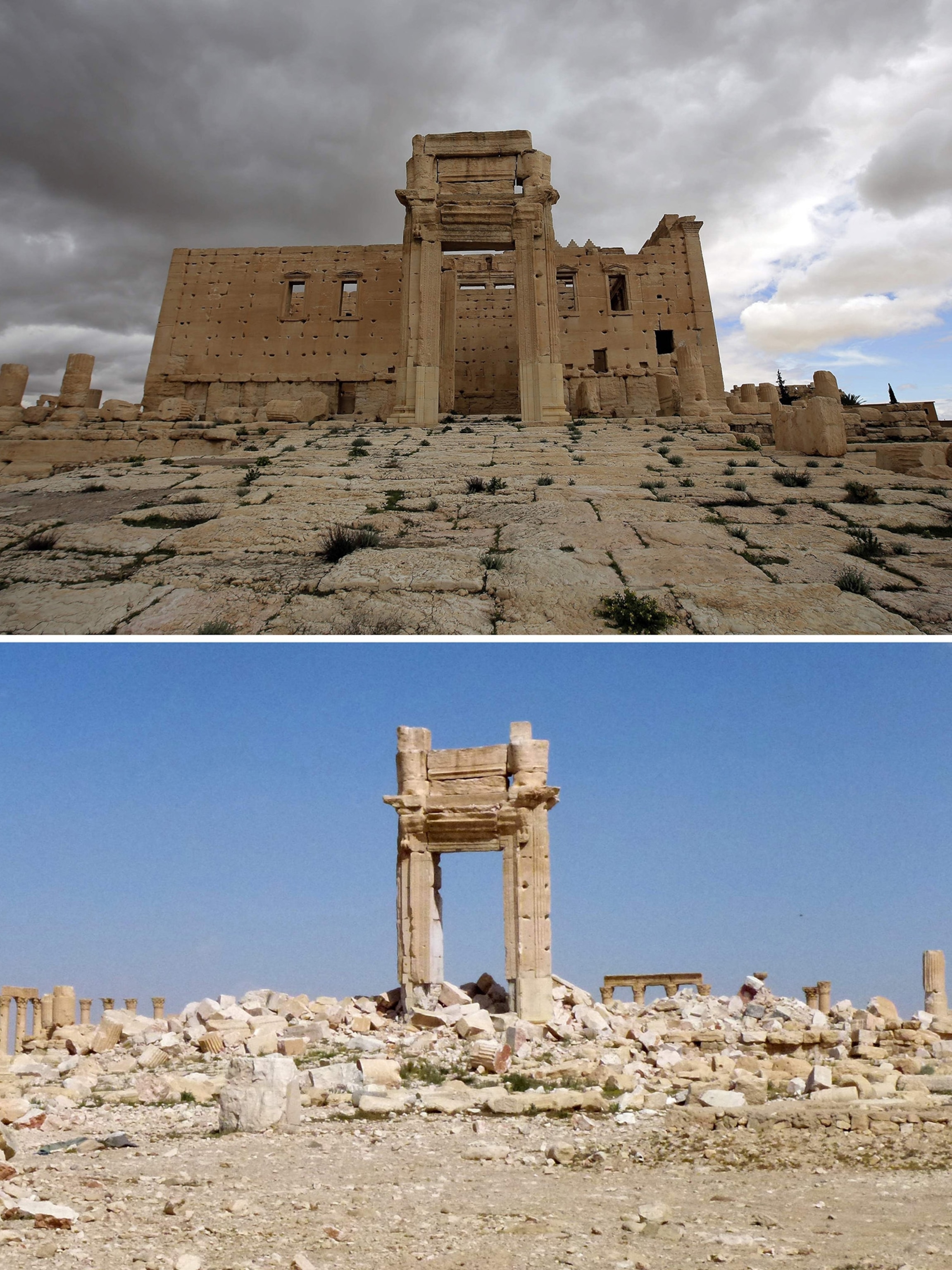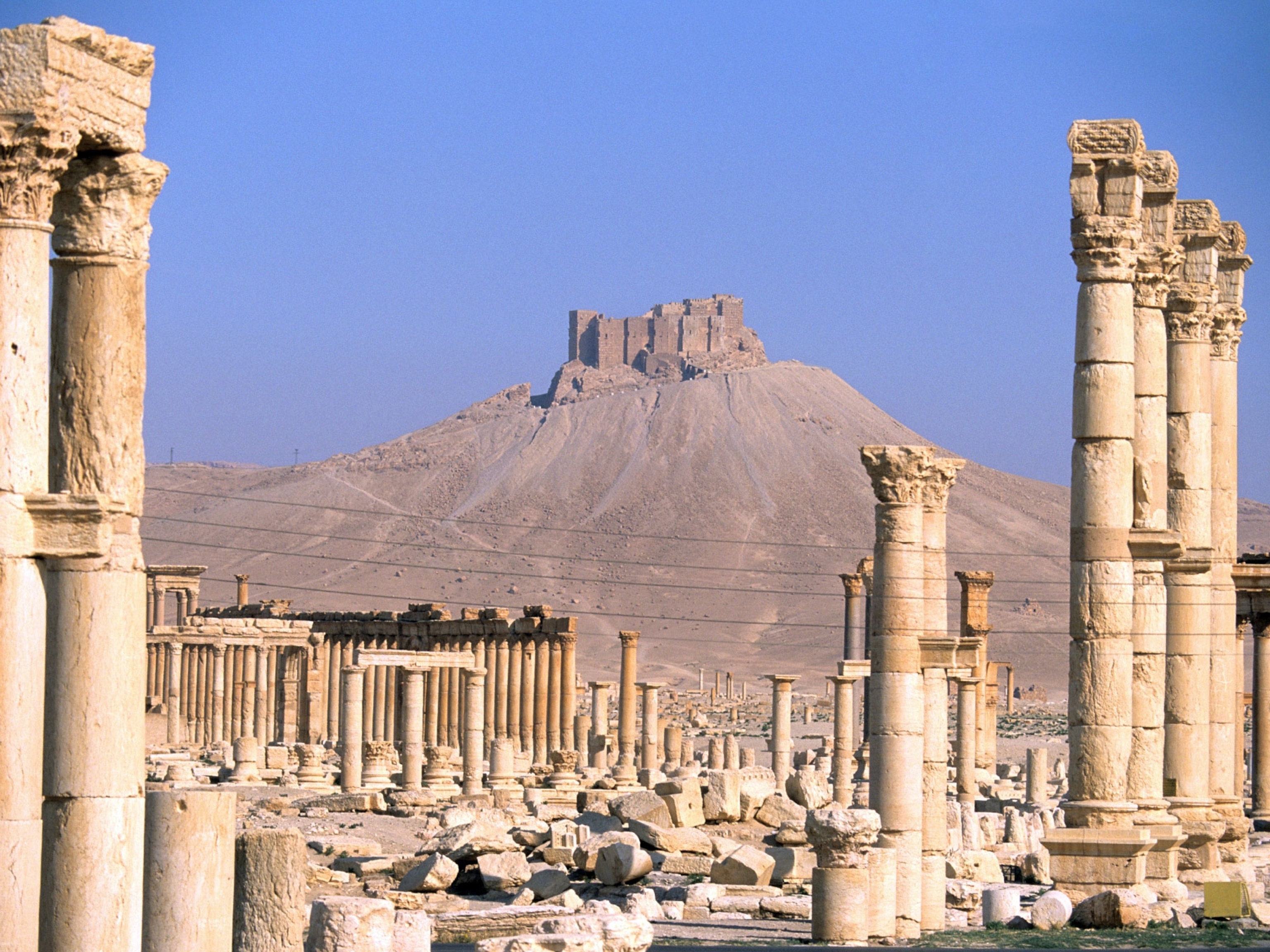






Why Palmyra, Recently Liberated, Is a Historical Treasure
Fabulously wealthy and distinctly multicultural, this desert crossroads also had a rebellious streak.
In Palmyra, history is literally written on the walls: across temples and above doorways, encircling funerary monuments and snaking up the towering limestone columns that rise above the Syrian desert some 134 miles (215 km) northeast of Damascus.
These inscriptions were often written both in Greek and Palmyrene Aramaic, a bilingual phenomenon unique to Palmyra. The site is a UNESCO World Heritage site that has been a focus of international attention since May of last year, when the Islamic State (ISIS) seized the territory around the ancient ruins.
On Sunday, the Syrian Army retook the city. The military is currently removing explosives and booby traps placed around Palmyra, after which specialists will arrive to perform a damage assessment on its monuments.
The inscriptions provide unique insight into life in a distinctive frontier city where, for centuries, local merchants controlled trade between the Mediterranean and Mesopotamia. (Read about out how Palmyra thrived in an infertile desert.)
One example: An inscription from around 130 A.D., in which the Senate of Palmyra honored a citizen named Male Agrippa for building a temple dedicated to Baal Shamin, the Semitic god of the heavens, to commemorate an earlier visit by the Roman emperor Hadrian. The bilingual dedication was inscribed at the entrance to the temple, which featured a unique mix of Roman and Near Eastern architectural styles.
Male Agrippa’s gift to his city, the Temple of Baal Shamin, was destroyed by the Islamic State last year, along with the Temple of Bel, Palmyra’s largest and most important temple, and the city's iconic Arch of Triumph. (Learn more about the Islamic State’s campaign against archaeological sites.)
Where East Met West
Palmyra (known until the Roman period as Tadmor) is mentioned in historical records as far back as 3,800 years. But it was in the first through third centuries A.D., that the desert oasis reached its height as a pivotal hub for trade between Rome and the Parthian and later Sasanian empires to the east.
Palmyrene merchants grew wealthy through taxing and protecting caravans that made their way across the Syrian desert to the Euphrates River and down to the Persian Gulf, ferrying gems and spices to the markets of the Mediterranean in return for precious metals, glass, and other luxury materials that have been found as far away as India.
Along with the caravans came a wealth of cultural influences, and among the thousands of inscriptions recorded at Palmyra are dedications to gods and goddesses from Phoenician, Babylonian, Arab and Canaanite traditions.
The Roman Empire controlled Palmyra to varying degrees over the centuries, and while the powerful merchants of this frontier town may have worshipped eastern gods, they also embraced the practices of the Roman elite, says Maura Heyn, an associate professor of classical studies at the University of North Carolina, Greensboro and a specialist in the city’s funerary monuments.
“Palmyrenes were cowboys on the frontier, so to speak, but they were also participating in an empire-wide practice of embellishing their city with grand buildings,” she says, citing iconic monuments such as the Temple of Bel, dedicated in 32 A.D., and the 1200-yard (1.1 kilometer)-long Great Colonnade, built in the 2nd to 3rd century A.D.
Local citizens memorialized their hefty donations to these massive building campaigns with inscriptions across the city.
The elite of Palmyra also took cues from Rome when commemorating their dead. While funerary monuments might feature Aramaic inscriptions, the people depicted on them would be dressed in Roman finery. “These monuments actually provide us with some of the best evidence for jewelry in the Greco-Roman world,” says Heyn. “There are few cities in the Roman Empire that provide such an abundance of evidence for cultural change and negotiation.”
Taking on Rome
Palmyra’s most famous citizen is undoubtedly Queen Zenobia, who leveraged the city's wealth and political chaos across the Roman Empire to briefly wrest control of the eastern Roman provinces of Egypt, Syria and Palestine and incorporate them into a larger Palmyrene Empire (269-273 A.D.). She was ultimately defeated and captured by the forces of Emperor Aurelian, who sacked Palmyra following a subsequent revolt.
The city never fully recovered, and the drastic decrease in wealth Palmyra once provided to Rome may have played a considerable role in the eventual decline of the western Roman Empire in the fifth century A.D.
Until the outbreak of conflict in 2011, Palmyra was one of Syria’s most popular tourist destinations, and modern Syrians feel a particular connection to the once-great merchant city that influenced and ultimately defied the power of Rome.
“Syrians consider Palmyra so special, because it's a source of pride for them,” explains Salam Al Kuntar, a Syrian archaeologist and visiting scholar at the University of Pennsylvania. “[They] feel very faithful to this past history and the monuments and art that signify it.”
Now, with the Islamic State routed from Palmyra, the ancient city celebrated for throwing off the yoke of western imperialism no longer faces an existential threat from fundamentalist militants from the east.
Related Topics
You May Also Like
Go Further
Animals
- How can we protect grizzlies from their biggest threat—trains?How can we protect grizzlies from their biggest threat—trains?
- This ‘saber-toothed’ salmon wasn’t quite what we thoughtThis ‘saber-toothed’ salmon wasn’t quite what we thought
- Why this rhino-zebra friendship makes perfect senseWhy this rhino-zebra friendship makes perfect sense
- When did bioluminescence evolve? It’s older than we thought.When did bioluminescence evolve? It’s older than we thought.
- Soy, skim … spider. Are any of these technically milk?Soy, skim … spider. Are any of these technically milk?
Environment
- Are the Great Lakes the key to solving America’s emissions conundrum?Are the Great Lakes the key to solving America’s emissions conundrum?
- The world’s historic sites face climate change. Can Petra lead the way?The world’s historic sites face climate change. Can Petra lead the way?
- This pristine piece of the Amazon shows nature’s resilienceThis pristine piece of the Amazon shows nature’s resilience
- Listen to 30 years of climate change transformed into haunting musicListen to 30 years of climate change transformed into haunting music
History & Culture
- Meet the original members of the tortured poets departmentMeet the original members of the tortured poets department
- Séances at the White House? Why these first ladies turned to the occultSéances at the White House? Why these first ladies turned to the occult
- Gambling is everywhere now. When is that a problem?Gambling is everywhere now. When is that a problem?
- Beauty is pain—at least it was in 17th-century SpainBeauty is pain—at least it was in 17th-century Spain
Science
- Here's how astronomers found one of the rarest phenomenons in spaceHere's how astronomers found one of the rarest phenomenons in space
- Not an extrovert or introvert? There’s a word for that.Not an extrovert or introvert? There’s a word for that.
- NASA has a plan to clean up space junk—but is going green enough?NASA has a plan to clean up space junk—but is going green enough?
- Soy, skim … spider. Are any of these technically milk?Soy, skim … spider. Are any of these technically milk?
Travel
- Dina Macki on Omani cuisine and Zanzibari flavoursDina Macki on Omani cuisine and Zanzibari flavours
- How to see Mexico's Baja California beyond the beachesHow to see Mexico's Baja California beyond the beaches
- Could Mexico's Chepe Express be the ultimate slow rail adventure?Could Mexico's Chepe Express be the ultimate slow rail adventure?



